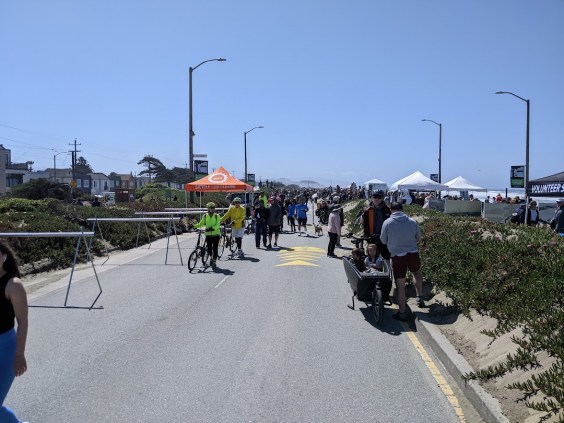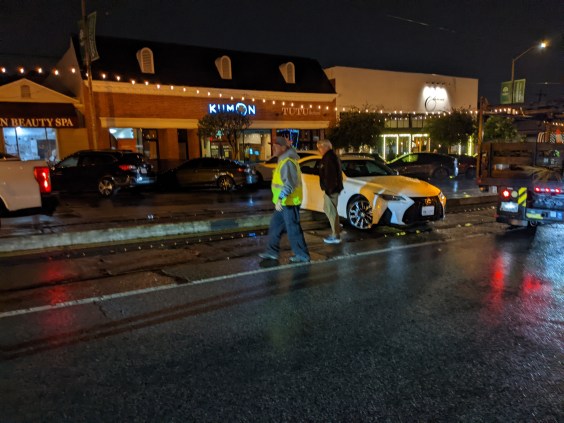Check out this cute video from the Caltrans S.B. 743 team, otherwise known as the VMT Reduction Branch. S.B. 743 was that bill passed ten years ago that said to planners: stop pretending that traffic congestion by itself is an environmental problem, and find a different way to measure the real environmental impacts from traffic. The agreed-upon replacement measure was "vehicle miles traveled," or VMT, a more intuitive way to think about how traffic from development affects the existing environment. Unlike the previous (still extant) measure, which said congestion was the problem, VMT measures whether a project would cause people to drive more.
In the past, only measuring whether traffic was slowed has led to "mitigating" congestion by making roads wider so more cars could drive through an area, which is not exactly the positive environmental outcome the state is looking for.
Anyway, it's a cute and useful video, even if it's not the most awesome in terms of production value (you might want to turn down the sound). It lays out the issues clearly: Accommodating cars means farther distances to travel, more traffic, emissions, and crashes, and more reliance on cars to get anywhere. "Our job now is to prioritize solutions that mitigate the impacts of climate change while equitably improving quality of life. To do so we need to rethink how we build so Californians can drive less," concludes the video.
Watch it, pass it around, teach and learn! It's a complicated topic that isn't always intuitive to people who are frustrated by traffic congestion.
However. Even though the VMT Reduction Branch clearly explains why we need to "build so Californians can drive less," the newsletter that includes the video also shows that Caltrans itself is not planning to "build so Californians can drive less." It highlights a project to widen Highway 99 in California's pollution-burdened Central Valley, saying the widening is a "rehabilitation" project that would "improve" the four-lane highway by making it a six-lane highway through Tulare County.
"Enhancement of this segment of the corridor in Tulare County is needed to improve truck freight throughput and travel time reliability as trucks account for a substantial portion of volumes," the newsletter states. "While the project will induce travel, strategies have been proposed with the potential to fully mitigate induced VMT" (emphasis most definitely added by Streetsblog).
Caltrans has "approved a Statement of Overriding Consideration" for the project, which basically means it has decided the induced travel is not as important as the need to accommodate anticipated new truck traffic. ("The trucking industry is one of California’s most valuable freight assets, particularly for the 'first and last mile' of a trip," states the document. "California must continue to develop, maintain, and operate a safe, efficient, and reliable freight transportation network to accommodate the truck volumes necessary to move freight within the state.")
And anyway, despite the induced travel the road widening will bring, the project's final environmental document is a "Finding of No Significant Impact" (FONSI). Does this let the road builders off the hook for those proposed VMT mitigation strategies mentioned above? That's not clear. The mitigations seem to be left to someone else to figure out, in the "State Route 99 Comprehensive Multimodal Corridor Plan for the Central Valley," which is yet to be written.
But here's the fascinating part: within the FONSI, the planners clearly state that they are not required to count freight truck traffic in their VMT analysis. "Heavy vehicles such as semi-trucks and large delivery trucks are excluded from transportation VMT analyses," they write.
This is true. The final rules stemming from S.B 743 specifically left out induced freight truck VMT from its requirements. This giant loophole is bad enough, given that truck traffic is not exactly less of a climate or air quality problem than cars and pickup trucks. But this document shows that Caltrans is hoping to drive a freight train through that loophole.
VMT analyses start with current traffic volumes, without distinguishing between freight truck or car travel. So, once the planners completed their VMT analysis of the Highway 99 widening, correctly using UC Davis' Induced Travel Calculator, they then estimated how much of that traffic was likely to be freight truck traffic and subtracted that from the total.
"It is reasonable for this project to include a reduction in the induced demand calculation and provide a calculation based on the Vehicle Miles Traveled generated by passenger cars and light-duty trucks," they write. Not only that, but since they expect the increase in freight trips AS A RESULT OF THIS HIGHWAY WIDENING to be "significantly higher" than the rate of new automobile trips, their calculation (subtracting the induced freight traffic) is "conservative."
In other words, since they are not required to count induced freight truck traffic, induced freight truck traffic really does not count.
The federal Clean Air Act, as well as people living along and/or traveling on Highway 99 or Highway 5, might have a different perspective on whether freight truck traffic ought to be counted. The road planners should account for air quality and climate impacts from that extra traffic, but they don't seem to have done so.
And one more thing: even though there are parallel freight rail lines in the Central Valley, they are "expensive" and "privately run," says the document, and therefore out of reach and not a potential VMT mitigation strategy. But the real reason rail is not even considered as a strategy for reducing traffic on Highway 99? "Transferring freight from SR 99 to the rail system would meet the purpose and need of the project but would not reduce the VMT impacts from the project" - presumably because Caltrans subtracted all that induced truck traffic VMT from their calculations.
It's still unclear why the Caltrans team tasked with reducing VMT is highlighting this highway expansion project. Is it an example of how they're not doing their job? It seems to show that California's road builders are pretty much unwilling to change their ways, no matter what the laws and the pretty video say.
California and the climate don't have time to waste on this kind of hair-splitting.






